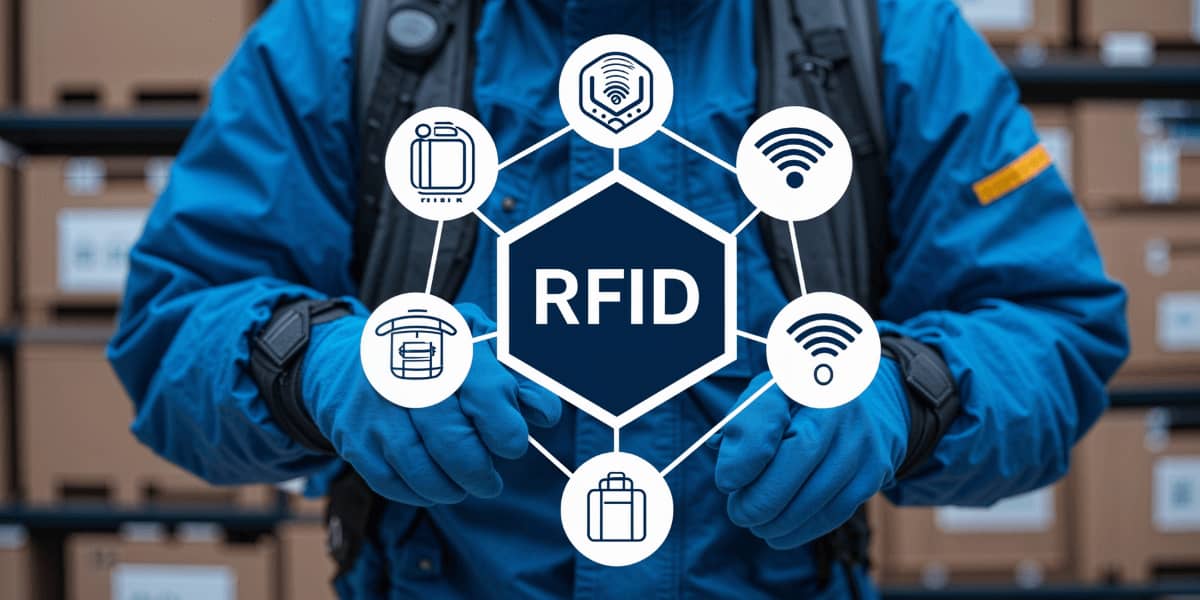 Call at :
+86 18681515767
Call at :
+86 18681515767
 Email :
marketing@jtspeedwork.com
Email :
marketing@jtspeedwork.com
 Call at :
+86 18681515767
Call at :
+86 18681515767
 Email :
marketing@jtspeedwork.com
Email :
marketing@jtspeedwork.com

Intelligent Management of Worshippers: How RFID Enhances Crowd Control in Temples and Churches In recent years, with accelerating urbanization and increasingly diverse religious activities, the flow of people in religious sites such as temples and churches has grown significantly—particularly during holidays and festivals. Traditional methods of managing worshippers, such as manual registration, paper tickets, or basic queue systems, are becoming inadequate. These outdated systems often struggle to maintain order and safety amid large crowds. In this context, Radio Frequency Identification (RFID) technology is gradually being adopted by religious institutions to optimize entry management, streamline crowd control, and improve activity tracking, thereby offering worshippers a more orderly, secure, and intelligent experience. 1. Key Advantages of RFID Technology RFID offers notable advantages such as contactless identification, fast reading speeds, and the ability to scan multiple tags simultaneously. Unlike QR codes or magnetic stripe cards, RFID does not require precise alignment with a scanner. Instead, it functions effectively within a certain range, making it ideal for managing large crowds. Additionally, RFID tags are reusable and can store dynamically updated data—making them highly flexible and suitable for long-term tracking of individual worshippers’ participation. 2. Common Applications of RFID in Religious Venues a. Entrance Control and Appointment Scheduling Take a Buddhist temple during the Lunar New Year as an example. Daily visitor numbers may reach tens of thousands. Manual ticket inspection is not only inefficient but also prone to bottlenecks. With RFID-enabled systems, temples can allow worshippers to make reservations online and issue RFID-enabled cards or wristbands linked to their personal profiles. At the site, automated gates scan the RFID tags to verify identity and reservation time slots, enabling time-based entry and reducing crowd congestion. b. Devotion Tracking and Merit Data Management For worshippers with regular habits such as daily incense offerings or charity donations, RFID systems can automatically record each action. RFID readers placed at offering stations detect the worshipper’s card or bracelet and update their records. Temples can then generate transparent reports on individual merit contributions, which help both in internal data management and in providing worshippers with a sense of participation and trust. c. Real-Time Location and Emergency Response During large-scale events like fasting rituals or Christmas masses, RFID systems can be integrated with real-time location services to monitor crowd density in key areas. When sensors detect that a particular hall is over capacity, the system can alert staff to redirect people. In the event of an emergency, RFID also helps locate specific individuals—especially the elderly or disabled—enabling faster and more targeted evacuation procedures. d. Volunteer an...

Psychiatric wards have long been considered one of the most challenging areas in hospital management. Patients often have unique conditions and unpredictable behaviors. Traditional methods—manual rounds and paper-based records—are labor-intensive and prone to errors. In recent years, as hospitals increasingly embrace digital transformation, RFID (Radio Frequency Identification) technology has been introduced in psychiatric settings, offering new tools to improve patient safety and maintain order. 1. Challenges in Psychiatric Ward Management Patients in psychiatric wards often suffer from cognitive disorders, impulsivity, or even aggression. Some are at risk of self-harm, suicide, or attempting to leave the ward unsupervised. These factors make strict identity verification and movement monitoring essential. In practice, incidents such as medication errors, patients entering restricted areas, or even going missing occur more often than in general wards. Once an incident occurs, it can be difficult to trace the exact timeline and assign responsibility. At the same time, the burden on psychiatric nurses is considerable. Night shifts, frequent identity checks, and managing visitors or caregivers consume time and energy, increasing the likelihood of human error. How to ensure safety while respecting patient dignity remains a key concern for administrators. 2. How RFID Is Changing the Game RFID uses radio waves to identify and track tags attached to objects or individuals. Unlike barcode systems, RFID works without direct line-of-sight and can read multiple tags simultaneously, making it ideal for complex environments. In psychiatric wards, RFID technology is primarily applied in the following areas: Accurate Identity Verification and Medication Safety Each patient wears an RFID wristband encoded with their personal and medical information. Before administering medication, nurses scan the wristband with a handheld device. The system automatically verifies the match, helping prevent medication errors due to mistaken identity or manual entry mistakes. Real-Time Location Tracking for Enhanced Safety RFID readers installed at key locations—such as hallways, restrooms, treatment rooms, and entrances—can track patient movements. If a patient remains in a restricted area for too long or frequently leaves their room at night, the system can send an alert to the nursing station for timely intervention. Restricted Zone Alerts for High-Risk Patients For patients with a history of escape attempts or self-harm, certain areas can be marked as "off-limits." If these patients approach those areas, the system will trigger an alert, allowing staff to take preventive action. Visitor and Caregiver Management Temporary RFID cards or lanyards can be issued to caregivers and visitors, allowing the system to log their entry times and track which zones they access. This improves overall ward security and traceability. Behavioral Data to Support Clinical Judgment Beyond real-tim...
As you stroll through a modern botanical garden, you might notice that the small plaques beside each plant not only display Latin names and origin information but may also conceal a tiny chip. This is a glimpse of how Radio Frequency Identification (RFID) technology is quietly integrating into the daily operations of botanical gardens. As information technology continues to evolve, botanical gardens are undergoing a digital transformation. RFID, as a key tool, is reshaping species management, visitor experiences, and scientific data collection. Challenges in Botanical Garden Management Traditional botanical garden management relies on manual records, physical labels, and paper archives. Over time, this approach has revealed several shortcomings, such as outdated information, damaged or lost labels, and time-consuming inventory processes. For large botanical gardens housing tens of thousands of plant species, precisely tracking each plant’s growth status, movement history, and research data is a massive and complex undertaking. In addition, with the growing demand for science education, botanical gardens face the challenge of delivering plant knowledge to the public in a more intelligent and interactive way. It is in this context that RFID technology has been introduced to botanical garden management systems. With its ability to enable contactless reading, batch identification, and real-time data updates, RFID effectively addresses many of the limitations of traditional management methods. The Basics of RFID and Its Suitability for Botanical Gardens An RFID system consists of tags, readers, and a management platform. Tags contain a chip and antenna that store basic plant information and management data. Readers communicate with tags via electromagnetic waves, enabling data collection and updates. The backend system integrates, analyzes, and presents this data. Botanical gardens typically use passive Ultra High Frequency (UHF) RFID tags. These tags do not require batteries, have low costs, long lifespans, and can be read from several meters away, making them ideal for large-scale deployments. Additionally, the tags must be highly weather-resistant to function reliably in sunlight, rain, humidity, and other challenging outdoor conditions. Some high-end tags even use environmentally friendly materials to ensure compatibility with plant environments. Practical Applications of RFID in Botanical Gardens 1. Accurate Species Management First and foremost, RFID greatly enhances the accuracy and efficiency of species management. Each plant is assigned a unique RFID tag at the time of planting. This tag is linked to detailed information such as species name, identification number, source of introduction, planting date, and growth records. These data are continuously uploaded to the management system, creating dynamic electronic archives. When horticulturists conduct plant inventory, maintenance, or relocation, they can simply scan the RFID tags with handheld...

As urbanization and digitalization accelerate, water supply systems—crucial components of city infrastructure—play a vital role in supporting residential life and industrial production. However, traditional water supply networks face numerous challenges in operations and maintenance (O&M), including aging pipelines, high leakage rates, difficulty in equipment location, and low repair efficiency. In response to these issues, smart water management has emerged as a critical direction for the transformation and upgrade of the water utilities sector. Among the enabling technologies, RFID (Radio Frequency Identification) stands out with its contactless identification, high-precision location capabilities, and real-time data management, making it a key player in enhancing the O&M efficiency of water supply networks. This article explores how RFID contributes to improving water network operations and analyzes its practical applications and value. 1. Challenges in Water Supply Network Operations a. Lack of Transparency and Incomplete Asset Records Traditional water utilities often rely on paper documents or scattered spreadsheets to manage infrastructure assets such as valves, water meters, joints, and manhole covers. These fragmented systems make it difficult to obtain real-time status updates, leading to inefficiencies in dispatch and maintenance. b. High Leakage Rates and Slow Response to Failures Aging pipelines, construction damage, and unauthorized water use contribute to high average leakage rates. Manual inspections are costly and slow, making it difficult to detect and resolve issues early. c. Difficult Equipment Location and Complex Pipeline Layouts In older urban areas, incomplete blueprints and overlapping underground pipelines complicate maintenance efforts. This often leads to accidental excavations and misaligned repairs. 2. Overview and Advantages of RFID Technology RFID is a contactless data identification and transmission technology that uses radio waves. An RFID system consists of three main components: RFID tags, readers, and a backend management system. In the water utilities sector, RFID tags can be attached or embedded into infrastructure components, each with a unique ID. These tags offer several advantages: Efficient Identification: Data can be read without physical contact or disassembly, streamlining asset inspections. Strong Durability: Specialized RFID tags are resistant to moisture, high temperatures, and corrosion—ideal for harsh water environments. Intelligent Logging: Maintenance schedules, responsible personnel, and performance data can be stored, forming a digital asset ledger. Accurate Positioning: When integrated with GIS (Geographic Information Systems), RFID enables precise location tracking of underground assets. 3. RFID Applications in Water Network Operations a. Digital Asset Management Valves, water meters, manhole covers, and pipe joints can be tagged with RFID, enabling full lifecycle information track...

With the rapid advancement of information technology, the exhibition industry is undergoing a transformation from traditional operations to intelligent systems. Whether it's entry management, exhibit tracking, or visitor behavior analysis, efficiency and experience have become key metrics in evaluating the success of an exhibition. As a vital component of the Internet of Things (IoT), Radio Frequency Identification (RFID) is increasingly demonstrating its value in exhibition scenarios. From streamlining entrance processes to optimizing exhibit management, RFID is reshaping the entire exhibition ecosystem. 1. Challenges and the Need for Transformation in the Exhibition Industry Traditional exhibitions often face the following management challenges: Long queues and inefficient manual verification: Large crowds during peak hours often lead to congestion and poor visitor experience. Frequent issues with counterfeit or borrowed passes: Paper-based badges are easily duplicated or shared. Poor exhibit tracking and high loss risks: Especially for high-value items, it's difficult to monitor movements accurately. Lack of real-time data for optimization: Organizers struggle to accurately grasp visitor flow, exhibit movement, and booth popularity. Against this backdrop, the exhibition industry urgently needs a secure, efficient, and traceable technology to support its digital upgrade. RFID, with its advantages in contactless recognition, batch reading, rewritability, and tracking capability, is emerging as a leading solution. 2. How RFID Works: Technology and Types RFID (Radio Frequency Identification) is a technology that enables contactless data transmission and identification via radio waves. It consists of three components: RFID tags, readers, and a backend management system. RFID systems are categorized into low frequency (LF), high frequency (HF), ultra-high frequency (UHF), and microwave based on operating frequencies, with each suited for different scenarios. In exhibition applications, HF and UHF RFID technologies are most commonly used. High-frequency (13.56 MHz) tags are typically used for entry badges and personnel tracking, while ultra-high-frequency (860–960 MHz) tags, with longer read distances and faster read speeds, are ideal for exhibit tracking and logistics monitoring. 3. RFID Applications in Exhibition Entry Management 1. Electronic Badges and Fast Entry Unlike traditional paper passes, electronic badges embedded with RFID chips enable fast, contactless identification. Visitors, guests, or media personnel simply walk near RFID-enabled gates to be automatically identified and logged in without the need for manual scanning or ticket checks—greatly reducing wait times. For example, at the China International Import Expo, RFID badges were implemented, increasing throughput per entrance lane by over three times. Each attendee's entry and exit times were recorded in real time, improving security and behavior tracking. 2. Preventing Counterfeit...

In today’s fast-paced world, misplacing or losing personal items is a common inconvenience. Whether it’s a phone, keys, wallet, or checked luggage during travel, such incidents can disrupt daily life or travel plans. As the Internet of Things (IoT) continues to evolve, RFID (Radio Frequency Identification) technology is emerging as a key solution to this problem. This article explores how RFID works and how it is being applied to track and manage personal belongings and luggage more efficiently. 1. Overview of RFID Technology RFID is a type of wireless communication technology that uses radio waves to identify and track objects without physical contact. A standard RFID system consists of three main components: RFID Tags: Attached to the object being tracked, each tag contains a chip and an antenna. RFID Reader: Emits and receives radio signals to communicate with tags. Back-End System: Collects and processes the data for analysis and visualization. RFID tags come in two types—active (with a battery) and passive (without a battery). Passive tags are smaller, less expensive, and well-suited for everyday applications such as tracking personal items. 2. Applications in Personal Belonging Management 2.1 Tracking Valuables For high-value items like laptops and cameras, RFID tags can be linked to user identities for real-time location tracking and theft alerts. Some smart bags and wallets now come embedded with RFID modules to notify users if the item is left behind or moved out of a predefined area. 2.2 Locating Everyday Items Small, easy-to-lose items such as keys, IDs, or remote controls can be tagged with compact RFID devices. Paired with a mobile app or voice assistant, users can quickly locate misplaced items. Popular consumer products like Tile and Chipolo offer such RFID or NFC-based tracking solutions and are widely adopted. 2.3 Managing Documents and Files Professionals such as lawyers, doctors, and researchers often handle large volumes of paper documents. By tagging folders or file envelopes with RFID labels, and using handheld readers, they can streamline document retrieval, filing, and loss prevention. 3. RFID in Luggage Tracking 3.1 Airline Baggage Management Luggage mishandling is a persistent problem in air travel. According to the International Air Transport Association (IATA), tens of millions of bags are delayed or lost annually due to damaged or misread tags. To address this, more airlines are deploying RFID-based baggage tracking systems. RFID tags are attached during check-in and scanned at every touchpoint—sorting, transit, and loading—ensuring visibility throughout the journey. Passengers can also track their baggage in real-time via mobile apps. Delta Airlines, for example, has implemented RFID baggage tracking across multiple airports, significantly reducing misrouting incidents and improving customer satisfaction. 3.2 Smart Suitcases Smart luggage brands like Samsonite and Away are integrating RFID or GPS modules into their p...

With the rapid growth of global trade, maritime transport—one of the pillars of international logistics—is undergoing a profound transformation toward digitization and intelligence. In this shift, Radio Frequency Identification (RFID), a core technology of the Internet of Things (IoT), is being increasingly adopted across various aspects of the shipping industry. From real-time cargo tracking to optimized vessel management, RFID is reshaping traditional maritime operations and providing powerful technological support for the realization of smart shipping. 1. Traditional Challenges in the Shipping Industry Traditional maritime systems often struggle with low tracking efficiency, opaque information flow, poor port operation management, and frequent human errors. For example, containers can be misplaced or delayed due to manual handling errors during transshipment or loading. Maintenance records for vessels are often paper-based or fragmented across multiple systems, making it difficult to manage the vessel lifecycle efficiently. These issues not only increase operational costs but also reduce customer satisfaction and supply chain stability. Therefore, the industry urgently needs a reliable and efficient method of data collection and transmission to enable full visibility and intelligent control over people, vessels, cargo, and ports. RFID technology has emerged as a critical solution to meet this demand. 2. Overview and Advantages of RFID Technology RFID is a wireless, contactless automatic identification technology. It consists of electronic tags (also known as transponders), readers, and backend systems. Compared to traditional barcode systems, RFID offers several distinct advantages: Contactless Reading: No line-of-sight is required, and tags can be read through materials like plastic or wood. Bulk Reading Capability: Multiple tags can be read simultaneously, greatly improving operational efficiency. Larger Data Capacity: Tags can store and update more information, supporting dynamic data management. Durability: RFID tags are dustproof, waterproof, and suitable for the harsh conditions of maritime transport. Real-Time Updates: Seamless integration with backend systems enables real-time information synchronization. Thanks to these advantages, RFID is transitioning from pilot projects to large-scale deployments in the shipping sector. 3. Applications of RFID in Cargo Tracking Containerized shipping is the dominant form of maritime cargo transport. By affixing RFID tags to containers, logistics companies can track cargo locations and statuses accurately and in real time throughout the entire transport process. 1. Automated Container Entry/Exit at Ports Traditionally, container entry and exit processes involve manual barcode scanning or handwritten records. With RFID, containers are automatically identified upon entering or leaving port areas. The system checks identity, verifies access rights, and plans routing, thereby increasing customs clearanc...

As global demand for resources continues to rise, particularly for energy, metal ores, and other natural resources, the ocean, as an untapped resource treasure trove, has become a focal point for many countries and enterprises. Marine mining and resource exploration hold tremendous potential, but due to the complex marine environment and the challenges of exploration depth and mining difficulty, technological advancements in this field have been limited. In recent years, RFID (Radio Frequency Identification) technology, an efficient automatic identification technology, has been applied across various industries and is now gradually showing significant potential in marine mining and resource exploration. This article will explore how RFID technology can improve the efficiency and sustainability of marine mining and resource exploration. 1. Overview of RFID Technology RFID is a technology that uses radio frequency signals for contactless identification. It consists of a tag and a reader, with RFID tags transmitting stored information to the reader through electromagnetic waves for automatic identification and tracking of items or data. The primary advantages of RFID technology include automation, long-distance identification, contactless operation, and fast and efficient data transmission. These features make RFID widely applied in industries such as logistics, healthcare, agriculture, and transportation. In marine resource exploration and mining, RFID technology can help improve equipment monitoring, resource management, environmental protection, and operational efficiency, providing technological support for the sustainable development of marine resources. 2. Application of RFID in Marine Resource Exploration Marine resource exploration involves the detection and collection of seabed mineral deposits, oil and gas resources, and other biological resources. Traditional methods of marine resource exploration rely on human divers, remotely operated vehicles (ROVs), and automated equipment. These methods are costly, inefficient, and pose significant safety risks. The introduction of RFID technology provides a new solution for material management, equipment monitoring, and data transmission during marine exploration. Tracking and Management of Subsea Equipment During marine resource exploration, equipment such as submersibles, detectors, and mining devices typically operate in deep-sea environments. By installing RFID tags on these devices, real-time monitoring and management of the equipment can be achieved. Each piece of equipment is equipped with a unique RFID tag, marking its location, status, and operating hours, and operators can use RFID readers for remote identification. This not only helps with real-time device location but also reduces the frequency of manual inspections, improving operational efficiency. Moreover, RFID tags can issue alerts in case of equipment malfunctions, reducing the risk of equipment damage and enhancing the safety and ...
Categories
New Products
JT-6210 0-1m UHF RFID Desktop USB Reader Writer ISO18000-6C Read More
JT-7100 0-3m 860-960MHz UHF RFID Industrial Grade RFID Reader Read More
JT-8380 0-6m UHF RFID 860-960MHz Middle Range Integrated Reader Read More
JT-P983 Industrial Tablet Pad RFID Handheld Reader Grade Long Range Android UHF Terminal Bluetooth RFID Reader For Warehouse Read More
JT-1550 Small Mini HF RFID 13.56MHz Module ISO14443A ISO 15693 Protocol Read More
JT-2302A 13.56MHz RFID Module ISO14443A ISO15693 Protocol Read More
JT-2302 HF RFID 13.56MHz Module ISO14443A ISO15693 Support Mifare1 IC card Read More
JT-2540 TM200 UHF RFID 4-port Module 860-960MHz TTL Read More
Copyright © 2025 Shenzhen Jietong Technology Co.,Ltd. All Rights Reserved.

IPv6 network supported